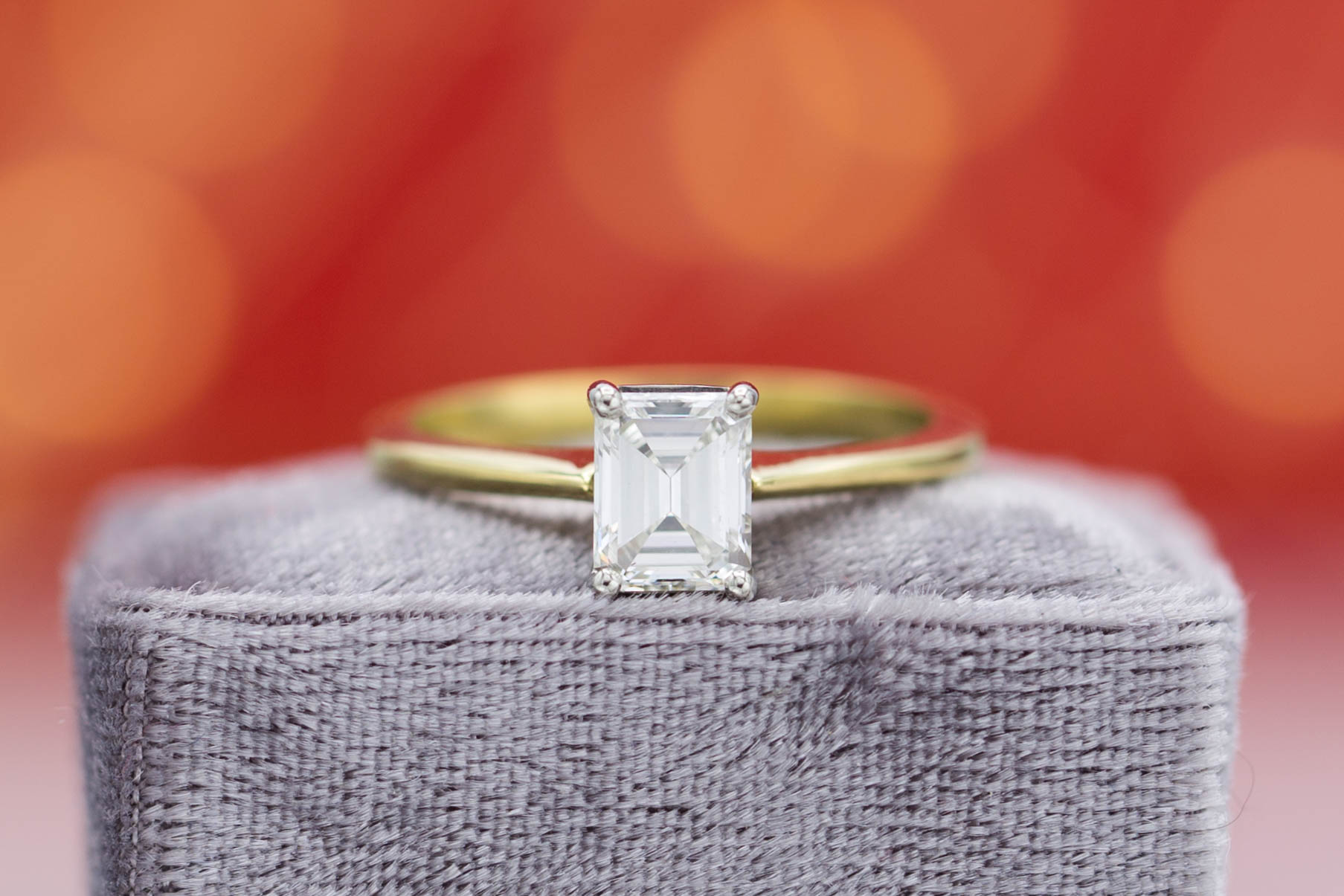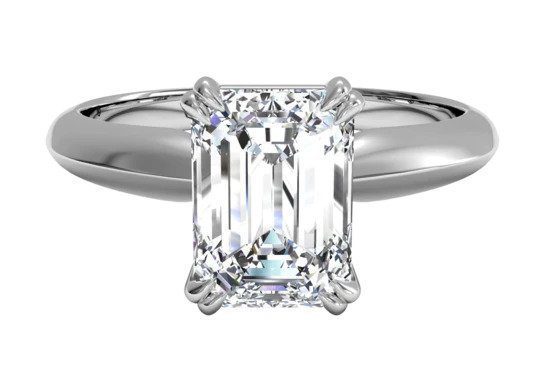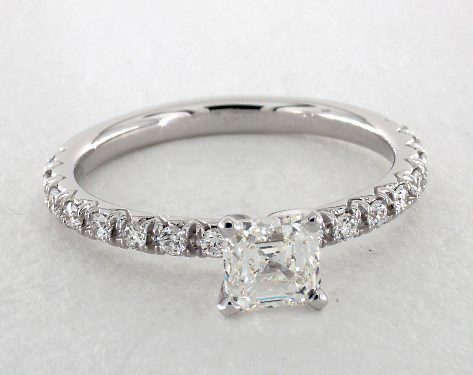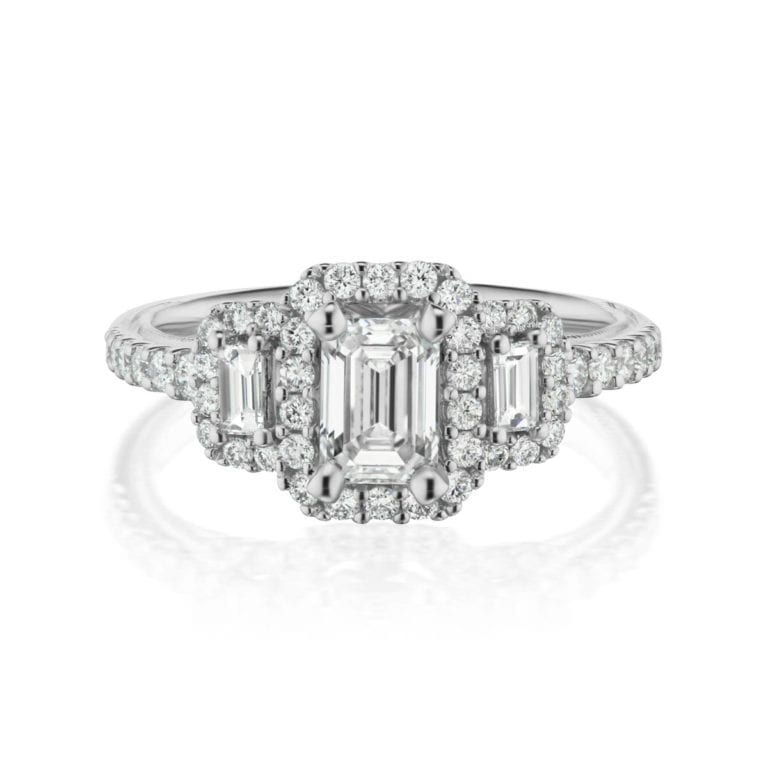Emerald Cut Diamonds vs Asscher Cut Diamonds: A Guide
The mesmerizing patterns of emerald & asscher-cut diamonds can give engagement rings a subtle style. Learn how to find a quality diamond within your budget!
10 Minute Read
Learn the pros and cons of emerald cut diamonds and asscher cut diamonds and how to find a high-quality diamond while staying within your budget.
Asscher vs Emerald Diamonds: Pros and Cons
at CustomMade
While most consumers are drawn to round brilliant diamonds for their incredible sparkle, emerald & asscher cut diamonds have a more subtle appeal. These fancy cut diamonds reflect light in broad flashes, offering a unique and sophisticated style.
at James Allen
Better yet, emerald & asscher cut diamonds are much cheaper than the ubiquitous round diamond. Take a look at these three 1-ct H-color VS2 diamonds. By choosing an emerald cut diamond or asscher cut diamond, you could save 35-40% or choose a larger center stone. With these cuts, you can find that perfect engagement ring without breaking the bank.
What's the Difference Between an Emerald Cut and an Asscher Cut?
Although there are slight differences in cutting patterns, the main difference between emerald and asscher cut diamonds is their shape. Both emerald and asscher cut diamonds are step-cut diamonds, meaning they are made of rectangular facets. Emerald cut diamonds are rectangles and have their corners cut out, while asscher cut diamonds are squares with cut corners nearly resembling an octagon.
The cutting patterns for emerald & asscher cut-diamonds have slight differences. However, you're unlikely to notice these unless you're a lapidary or gemologist.
at James Allen
Some emerald cut diamonds are square, causing extra confusion. However, their corners are less truncated than a true asscher cut diamond.
Emerald cut diamonds have an entrancing hall of mirrors effect, and their elongated shape looks very attractive on the finger. In addition, emerald cut diamonds appear much larger because of their shape.
at CustomMade
Asscher cut diamonds were first popularized in the 1920s and are perfect for vintage-style engagement rings. Their facets create a mesmerizing pattern that's seen a recent resurgence in popularity.
at CustomMade
Asscher vs Emerald: Judging Step-Cut Diamonds
The cut quality of step-cut diamonds, like emerald or asscher cuts, is more subjective than it is for round brilliants. While round brilliant cuts are carefully perfected to provide the most sparkle, step cuts reflect broadly, and a number of different angles can create a beautiful pattern of light.
But that doesn't mean every step-cut diamond looks great. Avoid diamonds that show large, dark areas.
In addition, consider the overall shape appeal. Make sure that the shape is symmetrical.
For asscher cut diamonds, make sure all 8 facets meet in the middle. Some poorly cut diamonds have corner facets that reach only part way to the center, leaving the diamond looking awkward. These stones lack the mesmerizing "windmill" effect seen in most asscher cut diamonds.
Length-to-Width Ratio
The length-to-width ratio (L/W) greatly affects the appearance of step cuts, especially in emerald cut diamonds. Most consumers prefer a L/W of 1.3 to 1.6, with the majority around 1.45. Take a look at these emerald-cut diamonds. What shape do you prefer?
Photos © James Allen. Used with permission.
Avoid the awkward zone of L/W 1.06 to 1.20. These diamonds will look off-square. For asscher cut diamonds, stick to a L/W of 1.00 to 1.05.
Depth
Unlike in round brilliant diamonds, the depth and angles in step cuts are less important. Instead, for step-cut diamonds, try to find a shallower diamond. Diamonds with more depth will "hide" their weight. In other words, deeper diamonds look smaller than shallow ones.
Always look at the measurements when comparing emerald cut & asscher cut diamonds. For example, take a look at these two 1-ct H color VS2 diamonds. The shallower stone is 6.88 x 4.80 mm, and the deeper one is 6.55 x 4.74 mm. That's a 6% difference in face-up area.
In these asschercut diamonds, there is a 10% difference in face-up size — and for the same price!
So, it's best to keep the total depth percentage at 67% and under. However, it's not a crucial measurement. Depths of 70% can still be well-cut stones. Above that, just know that you'll be paying for weight that you can't see.
Table
Again, there are no strict requirements when it comes to table size. The table is the large facet on top of the diamond that provides a window into the stone.
While it's best to avoid particularly large tables, as these can impair diamond performance, small tables pose less of a concern. Sticking to tablesunder 69% will help you find a great diamond.
Check out the tables on these three asschercut diamonds. The crown facets (on the top edges) of the diamond with the largest table appear squished, while the smaller tables look great! More importantly, this diamond's performance isn't as lively.
Photos © James Allen. Used with permission.
Polish and Symmetry
Although you may be tempted to limit polish and symmetry to "excellent," there's no reason to do this. Stick to polish and symmetry of "good" or better — you'll never know the difference.
Emerald vs Asscher: Clarity
Unlike brilliant cuts, step cuts don't hide imperfections. Make sure to look for imperfections under the table of the stone, as these are often visible to the eye.
Stick to a VS2 clarity grade ("very slightly included"). These are almost always eye-clean and less expensive than higher clarity grades. Why pay more for something that looks the same?
Still, with some searching, you may be able to find an eye-clean stone with the lower clarity grade of SI1 ("slightly included").
For larger emerald cut diamonds (>3 cts), keep in mind that the imperfections in a VS2 stone may be more visible.
To ensure eye-clean clarity, check out the laboratory report for a map of the diamond's imperfections. If you're using James Allen, take advantage of their experts, who will review the diamond with you and help you determine whether it's eye-clean.
Asscher vs Asscher: Color
Fancy cuts also tend to show more color than round brilliant diamonds. For emerald cut & asscher cut diamonds, an H color diamond will appear white. Although higher color grades will appear slightly whiter, you'll never notice the difference in color. However, you'll notice the difference in the price tag!
If you've chosen a halo, side stone, or three-stone setting, try to match the side stones in color grade. A color range for these diamonds should be shown in the ring details.
at James Allen
For rose gold and yellow gold settings, I color diamonds will still appear white.
at James Allen
Since diamond color is determined by the body color, not the face-up color, you may be able to find a J or K color diamond that faces up white.
at James Allen
Emerald & Asscher Cut Lab Grown Diamonds
Should I Buy an Emerald or Asscher Cut Lab Grown Diamond?
Lab grown diamonds are reshaping the jewelry marketplace. Now that we can cost effectively manufacture diamonds in a lab, the supply of lab diamonds is plentiful. This means savings for you as a consumer. So if you are on a budget and looking for an emerald or asscher cut diamond, a lab grown diamond might be a great fit for you.
Lab grown diamonds are not to be confused with diamond simulants like cubic zirconia or moissanite. They are the exact same in chemical and optical properties and are a great, cost-effective alternative to natural diamonds.
For more details about lab-grown diamonds, read our complete Lab-Grown Diamond FAQ and our Lab-Grown Diamond Buying Guide.
Check out two identical diamonds below from James Allen to see the value of lab grown diamonds compared to a natural diamond.
at James Allen
at James Allen
How to Buy an Emerald or Asscher Cut Lab Grown Diamond
The process of buying either a lab grown diamond or a natural diamond is the same. Many online retailers like James Allen, Blue Nile and With Clarity offer lab diamonds. Each of these retailers clearly differentiates lab and natural diamonds on their diamond selection tools. You can examine the properties of the diamond and see 360° videos of stones. From there, you can select a setting to complete the perfect piece. These reputable online jewelers make buying a lab grown diamond easy and enjoyable.
Here's an example of two identical lab grown asscher cut diamonds from two different online jewelers for inspo.
at James Allen
at Blue NIle
Emerald-Cut vs Asscher-Cut Summary
- 1. The primary difference between emerald cuts and asscher cuts is the shape.
- 2. These cuts are perfect for vintage-style engagement rings.
- 3. An H color or above will appear white.
Best Budget - Blue Nile
Best Value - James Allen
Emerald & Asscher Cut Fancy Colored Diamonds
The allure of naturally colored diamonds lies not only in their rarity but also in the way their colors are displayed within the facets of well-cut stones like emerald and asscher cut diamonds. Natural colored diamonds are extraordinary gemstones that captivate with their enchanting hues, offering a breathtaking departure from the traditional white diamond.
The spectrum of natural colored diamonds spans a diverse range, including delicate pastels like pinks, blues, and yellows, as well as intense and rare colors such as greens, purples, and reds. Each diamond tells a unique story, and jewelry made with these exquisite gems leaves a long-lasting impression. Natural colored diamonds offer an unforgettable and special option for those seeking to make a statement with their jewelry.
at James Allen
Where Should I Buy Emerald & Asscher Cut Diamonds?
If you're buying an emerald cut or asscher cut diamond online, always buy from a reputable dealer and review their return and exchange policies. For these cuts, it's essential that you can review the clarity imperfections and see how the diamond performs. Blue Nile and James Allen both offer high-quality, close-up 360° videos of their diamonds.
In addition, James Allen has diamond experts ready to review your choices with you. They will help you determine if the stone is eye-clean and whether it has surface-reaching imperfections that can weaken the stone. They also offer an extensive selection of ring designs to choose from! Search James Allen's diamonds based on our recommendations.
Blue Nile does offer one advantage when shopping for emerald cut diamonds. They allow you to limit your search by the L/W ratio. If you're picky about the shape or looking for a replacement stone, this feature will help you narrow your choices.
If you just can't seem to find what you're looking for, consider using a custom jeweler such as CustomMade. Their experts will help you design an engagement ring you'll love with a diamond you'll cherish for years to come.
FAQS
1. Is Asscher cut more expensive?
Asscher cut diamonds can be more expensive than other cuts of diamond, but are still less expensive than round brilliant-cut diamonds. Some cuts, like princess cuts, are able to use up a lot of a diamond's rough and minimize wasted material. The shape of asscher cuts wastes more rough, creating a smaller gem for the same price.
2. What is special about asscher cut diamond?
Asscher cut diamonds are popular for their art deco style, giving them a sought-after vintage look. Their symmetry creates an X shape in the center of the diamond, giving the gem an exceptionally unique look. The broad facets of asscher cut diamonds allow the viewer to see straight through the stone, so only diamonds of exceptional clarity will be used for these unforgiving cuts.
3. Do asscher cut diamonds look bigger?
Asscher cut diamonds are cut deeper than other cuts, hiding their weight and causing them to look smaller. If you're looking to maximize the visible size of your gem, opt for an asscher cut diamond with a depth percent under 67%.
4. What is the cheapest cut of diamond?
All fancy cut diamonds are significantly cheaper than round brilliant cuts but cushion, emerald, and asscher cuts are some of the least expensive choices. If you are flexible on the shape of your gem, you may want to compare multiple fancy cuts, as the cheapest cut of diamond fluctuates depending on the size you are looking for.
Addison Rice
A geologist, environmental engineer and Caltech graduate, Addison’s interest in the mesmerizing and beautiful results of earth’s geological processes began in her elementary school’s environmental club. When she isn’t writing about gems and minerals, Addison spends winters studying ancient climates in Iceland and summers hiking the Colorado Rockies.
Related Articles
Diamond Value, Price, and Jewelry Information
Is a Super Ideal Cut Diamond Worth It?
Is an SI2 Clarity Diamond Eye-Clean?
Is a D Color Flawless Diamond Worth the Price?
Latest Articles
800 Years of Mogok: A Celebration in Tenuous Times
What is the Average Gemstone Faceting Yield?
Pyroxmangite Value, Price, and Jewelry Information
How to Identify Emerald Simulants and Synthetics
Never Stop Learning
When you join the IGS community, you get trusted diamond & gemstone information when you need it.
Get Gemology Insights
Get started with the International Gem Society’s free guide to gemstone identification. Join our weekly newsletter & get a free copy of the Gem ID Checklist!



